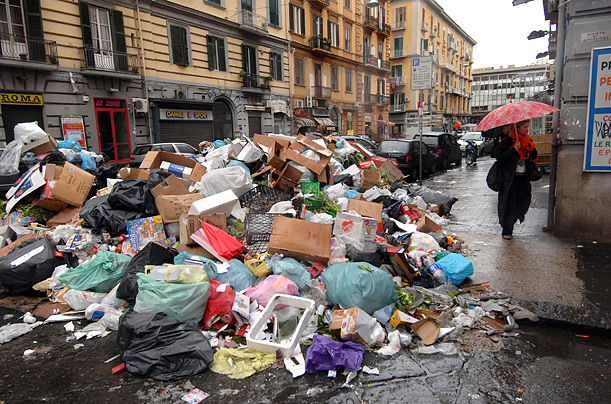Once a week you set your garbage cans out by the street so that some anonymous hard working individual can come by and make them go away. Usually this happens during the wee hours of the morning and those loud mechanical/hydraulic noises cause you to wake up 30 minutes before you normally do, but hey the guy has a job to do (and a very important one at that). Although often unappreciated the garbage company makes your waste disappear before it turns into a reeking, decaying, rodent attracting maggot filled pile of nastiness. What happens after T-SHTF and the trucks stop their weekly rounds? The average American produces 4.4 pounds of trash daily, which equates to around 1600 pounds per year. Do the math on that for a family of four, 123 pounds of trash per week (give or take a few pounds) not including how much your neighbors produce. If the trucks stop coming that is going to pile up very quickly in your garage or backyard and present severe health risks to the community. What will your plan be to dispose of all of this trash, will it be to leave it in the open, burn it or bury it?
Outdoor Trash Considerations
This is the least palatable option, quite simply leaving your trash out in the open air. In addition to the horrible smell trash piles can attract many unwanted creatures, all of which have the potential to harbor some pretty nasty diseases.
Imagine living next door to a yard full of trash. Not only is it unsightly, one woman says it’s bringing rodents and roaches to her home. “There was a big rat on our roof. Mice come out at night. And, then there are cockroaches really big that are coming,” says Laura Hermosillo, who lives next door. “And, we’ve killed a couple of them already, but they fly, they flew.” Laura Hermosillo and her family have lived in their east Bakersfield home for nearly a decade. They say their neighbor’s trash started piling up four months ago, after the elderly woman who lived there moved into a senior home.
Burning Trash Considerations
One obvious problem with burning trash is that it sends a signal to everyone within a few miles that you exist, be it visually or through smell. Additionally the toxins produced by burning trash can be very harmful to one’s health and respiratory system in particular. Soldiers deployed overseas found this out when they were consistently exposed to fumes from large burn pits.
The burn pit at Balad has consumed Styrofoam, unexploded ordnance, petroleum products, plastics, rubber, dining facility trash, paint and solvents, and medical waste, including amputated limbs, according to Curtis’ memo. He said contaminants, many highly poisonous, that troops may have been exposed to include benzene, an aircraft fuel known to cause leukemia; arsenic; dichlorofluoromethane, or Freon; carbon monoxide; ethylbenzene; formaldehyde; hydrogen cyanide; nitrogen dioxide; sulfuric acid; and xylene. “It is amazing that the burn pit has been able to operate without restrictions over the past few years,” Curtis wrote.
While a neighborhood burn pit might not come close to rivaling the size and scope of a large military burn pit overseas there are still dangers associated with tossing a match into a pile of collected garbage. According to the EPA toxins produced by burning trash are still present in quantities significant enough to raise concern.
Backyard burning can emit pollutants such as hazardous air pollutants (HAPs), particle pollution, and volatile organic compounds (VOC). These pollutants can contribute to health problems that may affect homeowners, their families, their neighbors, and the community. While state, local, and Tribal regulations limit the amount of backyard burning, dangerous releases of HAPs can occur if a homeowner does not comply with these regulations.
Buried Trash Considerations
If you have a pickaxe and a shovel this is probably your best course of action. However there are still certain precautions that must be taken into account when tossing your trash into a pit, especially if SHTF lasts for a considerable amount of time. Buried trash decomposes very slowly, has the potential to release methane gas and could contaminate groundwater supplies.
If your trash goes to a landfill it will end up sealed in the ground. It won’t decompose much, if at all, because air and water can’t get in. “Most landfills are more like mummifiers than composters,” wrote Elizabeth Royte in ‘Garbage Land.’ Landfills have some adverse environmental impacts. Despite careful engineering, they can leak liquids into the groundwater. Landfills also release one-fourth of all methane; landfill and wastewater treatment gases made up 2.3 percent of U.S. greenhouse gas emissions in 2005.
The bottom line is that while it surely does not fall into one of the more well known prepper categories, a plan of action for trash disposal must be in place for SHTF or there could be great risk to human health and safety within your home and community. Focusing solely on security and food in your prepper plan could lead to several unintended consequences, many of which could be more threatening to your safety than cannibalistic evil doers bent on anarchy. Discuss your trash disposal plan with your family and community and be prepared to implement it if/when the time comes.










4 comments
Skip to comment form
PJ, I’m going to put my nose in again. There are other options.
http://suburbanprepper.blogspot.com/2012/12/off-grid-what-to-do-with-trash.html
Author
Texas Blue,
I read your article, great job. I can understand your concern over what I wrote and I do agree with many of your points. “Trash” as we know it will be re-purposed after the collapse and our production of garbage will be greatly reduced. However in the initial stages of SHTF (or a collapse) I think we could be faced with a few months where this thriftiness is relatively non-existent. These times pose the greatest danger to our communities, where people who haven’t fully grasped the situation just keep tossing their waste out by the street assuming that “things will get back to normal” and someone will magically fix things. Again great article and I have no problem with people disagreeing with me…it keeps me sharp!
take care
PJ
I’m afraid you’re probably right, but I hope it doesn’t take months- especially in places with denser populations. I’ve seen places like that, and the rats are terrible. I’m hoping some community organizers step up before it gets that bad, and wanted to present some other options.
There will also be people too lazy to dispose of things properly even when your community comes to an agreement on how waste should be handled. The digester is something prepared families can set up ahead of time, so that at least the vermin will find fewer things to appeal to them at their houses.
Ok I am a bit new to all of this prepping stuff, but I don’t understand how burying a garbage can half way down in the dirt helps?